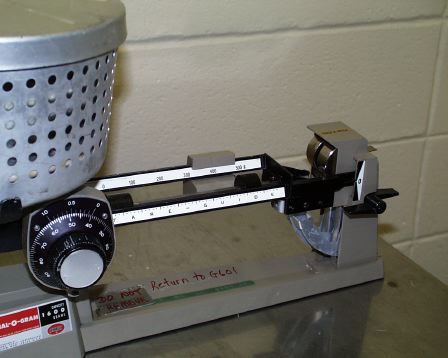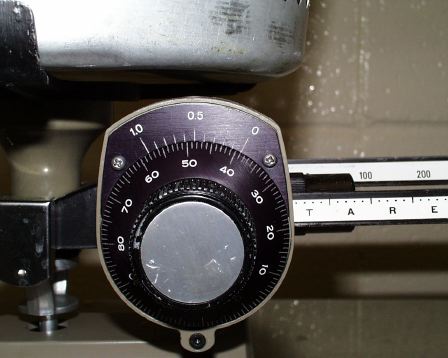Weighing the Rat
Because we are keeping the rats at 85% of their free feeding weight it is important that we maintain an accurate record of the rats' weight. If a rat falls below the 85% level we will provide more food to bring its weight back to an acceptable point. Keep in mind that while we do not want the rats to go below 85% of their free feeding weight if they do drop a bit lower than this they are in no immediate danger. However, for the purposes of the experiments that we are running during the term 85% is a good level: it keeps the rats a little hungry so that the food reinforcers provided during the studies serve as good motivators.
 To weight the rats we will use the balance scale shown to the right. It is actually quite an easy piece of equipment to use, although one needs to be careful when reading the grams off the dial. But more on that later. The first thing to do is remove the cover from the metal basket. Then, lift your rat from his homecage and deposite him in the basket. When you put the lid back on the basket be careful not to catch the rat's whiskers or toes. You do not have to force the lid on tight. Just resting the lid on the basket lip will be sufficient to keep your rat in the basket while you weigh him. One word of caution: do not leave your rat in the basket without the lid on for any length of time. Rats are inquisitive little animals and they will often jump out of the basket to go see what else they can get into.
To weight the rats we will use the balance scale shown to the right. It is actually quite an easy piece of equipment to use, although one needs to be careful when reading the grams off the dial. But more on that later. The first thing to do is remove the cover from the metal basket. Then, lift your rat from his homecage and deposite him in the basket. When you put the lid back on the basket be careful not to catch the rat's whiskers or toes. You do not have to force the lid on tight. Just resting the lid on the basket lip will be sufficient to keep your rat in the basket while you weigh him. One word of caution: do not leave your rat in the basket without the lid on for any length of time. Rats are inquisitive little animals and they will often jump out of the basket to go see what else they can get into.
 After you have placed your rat in the basket you will need to adjust the weights. The objective is to get the black pointer to line up with the "zero" on the far right of the scale's arm (see picture to the right). When the pointer (i.e., on the end of the freely moving scale arm) lines up with the zero line then you've successfully balanced the scale. The first thing you need to do is move the "hundreds" weight to the appropriate place. The hundreds weight is the large rectangular weight on the back of the scale arm. Although it hard to see in the photo, the scale arm is marked off in hundreds (i.e., "100", "200", etc.). You will probably need to set the hundreds weight at the "400" point. You will know if you have gone too far if the pointer drops below the zero line.
After you have placed your rat in the basket you will need to adjust the weights. The objective is to get the black pointer to line up with the "zero" on the far right of the scale's arm (see picture to the right). When the pointer (i.e., on the end of the freely moving scale arm) lines up with the zero line then you've successfully balanced the scale. The first thing you need to do is move the "hundreds" weight to the appropriate place. The hundreds weight is the large rectangular weight on the back of the scale arm. Although it hard to see in the photo, the scale arm is marked off in hundreds (i.e., "100", "200", etc.). You will probably need to set the hundreds weight at the "400" point. You will know if you have gone too far if the pointer drops below the zero line.
 Once you've got the scale balanced to within one hundred grams of the rat's weight you need to adjust the dial (see picture to the right) on the front of the scale to get the precise weight of the rat. By turning the dial you will be able to get the scale's pointer to line up with the zero line.
Once you've got the scale balanced to within one hundred grams of the rat's weight you need to adjust the dial (see picture to the right) on the front of the scale to get the precise weight of the rat. By turning the dial you will be able to get the scale's pointer to line up with the zero line.
 Once you have balanced the scale you need to read the weight. To do so read the hundreds on the back of the scale arm and add to it the value on the dial. So, in the example shown in the pictures the hundreds weight is at the "400" mark. If you click on the picture to the right for an enlargement you will see that there is a "zero" mark on the outer rim of the dial and a scale of 0 to 100 on the inner rim of the dial. To read the dial weight on the dial see what number on the inner rim matches up with the line below the zero on the outer rim. In the picture shown here the value is "39". Therefore, the rat's weight is 439 grams (i.e., 400 from the hundreds weight plus 39 from the dial). Once you have this weight remove your rat from the basket and return him to his homecage and record his weight on the sheet provided.
Once you have balanced the scale you need to read the weight. To do so read the hundreds on the back of the scale arm and add to it the value on the dial. So, in the example shown in the pictures the hundreds weight is at the "400" mark. If you click on the picture to the right for an enlargement you will see that there is a "zero" mark on the outer rim of the dial and a scale of 0 to 100 on the inner rim of the dial. To read the dial weight on the dial see what number on the inner rim matches up with the line below the zero on the outer rim. In the picture shown here the value is "39". Therefore, the rat's weight is 439 grams (i.e., 400 from the hundreds weight plus 39 from the dial). Once you have this weight remove your rat from the basket and return him to his homecage and record his weight on the sheet provided.
|